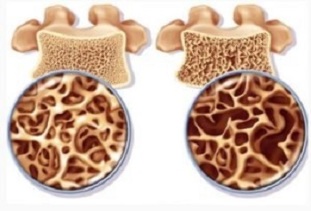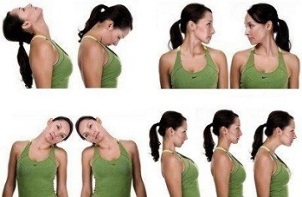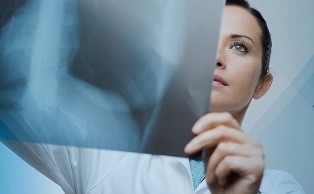An accurate diagnosis can only be made by a doctor. An experienced neurologist is involved in the treatment. He appoints additional studies to determine not only the stage of development of the disease, but also the cause of its development. It is then much easier to choose the optimal therapy regimen, saving the patient from the main manifestations of the disease.
Visible signs of cervical osteochondrosis in women appear when the disease is already actively developing in the body. The slightest concern in well-being is a reason to see a doctor. If you have a problem, then over time, osteochondrosis will turn into elongation or hernia, the patient will be on the operating table. The consequences of the disease will remain for life. At an early stage of disease development, its symptoms can be completely eliminated. It is in your power to improve your health, to assure yourself of an active, full future without injury, dystrophic tissue changes and constant pain.
What is osteochondrosis
Osteochondrosis is a common disease characterized by changes in the structure of cartilage tissue in the intervertebral discs. This disease can affect any joint, but most often affects the spine. There are clear signs of osteochondrosis in women, but final conclusions about the development of the disease can only be made after a comprehensive diagnosis.The cervical spine is considered the most mobile. This area is often prone to various dystrophic lesions because it is less protected. There are no large muscles to protect and support the spine. The department consists of seven separate beads. They are based on bone tissue. Between each vertebra there is a soft "layer" - the intervertebral disc, which provides flexibility and mobility of the neck. Hormones play a major effect on tissue structure, therefore, osteochondrosis develops in different ways in women and men.
According to statistics, 60-70% of the mature population of the planet suffers from this disease, and in 30% of cases, the cause of persistent headaches, migraine is precisely osteochondrosis of the cervical spine.
To understand when to see a doctor, you should study the list of symptoms of the disease.
Why osteochondrosis is dangerous for women

The main symptoms of osteochondrosis in women are considered more carefully because the weaker sex suffers more from the disease.
This is due to the structure of the female body:
- Muscle tissues are less developed and pumped in women than in men, this is an aggravating circumstance in the development of the disease;
- Women are more likely to work in the office, spending a lot of time sitting in a computer position;
- The hormonal background of the female body is radically different from that of the male; during menopause, dystrophic changes in cartilage tissue thickness become more pronounced.
In adulthood, women gradually deteriorate bone tissue. This is due to the development of osteoporosis. Calcium is washed from the bones and its reserves are not replenished. The female body no longer produces a specific hormone that stimulates the absorption of the trace element. If both cartilage and bone are destroyed at the same time, the consequences can be dire.
For this reason, women over the age of 40-45 are recommended to have their blood calcium levels tested every year to check the condition of their bones and cartilage. Some preventive measures will help to get rid of the manifestations of the disease, to restore the integrity of the cervical spine in a timely manner.
With osteochondrosis, the structure of cartilage tissue changes, becoming denser and stiffer. The flexibility and mobility of the vertebrae is lost. If this disease passes into the intervertebral weight, then the contents of the disc protrude beyond the annulus fibrosus. Getting rid of such a complication without surgery is problematic. It is not worth bringing him into such a state. try to monitor your health.
Main manifestations of the disease at an early stage
Signs of cervical osteochondrosis in women vary in the early and late stages of development. At first, the disease is almost not annoying, but it is still worth paying attention to the small symptoms.This list includes:

- Neck discomfort, especially in the morning;
- Crunch during circular movements of the head, leaning sideways;
- Frequent headaches;
- Slight dizziness with a sharp turn of the head sideways.
Due to structural changes in the tissues, the nerve roots are compressed, which provokes a headache.
The neck is no longer flexible. In women, it is often observed to go forward.
it is increasingly difficult to maintain posture, sometimes even a slight lump appears in the passage from the neck to the shoulder girdle. All this clearly indicates the development of osteochondrosis.
Instead of scheduling an appointment with a neurologist, women go through numerous massage courses. This effect has a short-term effect. If you massage incorrectly, then over time it will cause even more damage to the body.
Specification of the course of cervical osteochondrosis
Osteochondrosis of the cervical spine in women can be asymptomatic for a long time. Limited neck mobility attributed to fatigue, muscle blockage, headaches are not yet very disturbing. And if they happen, then they call them guilty, stress, bad sleep. A provocative factor for the transition of the disease from a latent form to an acute form may be a sharp hypothermia, minor damage. Often, the disease develops at a reactive rate. Yesterday the woman was still feeling well, but today I can not lift my head from the pillow due to severe pain. Do not expect this state to disappear by itself. Hurry to see a doctor. Even at this stage, you can completely get rid of the manifestations of osteochondrosis, provoking its factors.
It is strictly forbidden to contact bone grafters, osteopaths. There is no such concept as "bead reduction" in official medicine. Such specialists will only hurt. Due to excessive mechanical stress, cracks can appear in the thickness of cartilage and bone tissue. During the first session with an osteopath, you will feel better, but all his actions over time will only lead to the fact that osteochondrosis turns into a major hernia.
Traditional treatment consists of several stages, it is always performed continuously, without pain. Any activity during the acute period is prohibited. To get rid of limited movement, strong pain, you just need to listen to the main recommendations of your doctor. can be observed simultaneously by a neurologist and a vertebrologist. These highly qualified physicians with higher medical education apply complex methods of treatment.
Acute symptoms

When the disease becomes acute, the symptoms of cervical chondrosis in women change.
At this stage, the overcrowded cartilage tissue presses on the nerve endings, squeezing the large arteries that run along the spinal cord to the brain, feeding it. oxygen starvation is manifested by frequent fainting. Possible short-term memory loss, spatial disorientation.
Due to the clotting of the nerve endings, the sensitivity in the limb is lost. A feeling of numbness in the shoulder girdle, a tingling sensation in the fingers is very alarming.
If you are not in a hurry to start treatment at this stage, there is a possibility of developing partial paralysis. The patient ceases to feel the upper limbs at all.
If you consult a doctor at this stage, then at first all his efforts will be directed to stabilize the patient's condition.
After withdrawal from the acute period of the disease, various methods of therapy are described, which include taking medication, undergoing a course of various physiotherapeutic procedures.
Exercise therapy is very effective if the classes are conducted by a certified instructor who has sufficient experience in rehabilitating patients with spinal cord injuries.
Diagnostic methods
The diagnosis of cervical spine osteochondrosis is made comprehensively. When you first visit a doctor, you describe in detail all the disturbing symptoms. The doctor, already on the basis of this information, can draw certain conclusions about the development of the disease. The final diagnosis can be made only after additional research. Innovative functional diagnostic methods are increasingly being used in medical practice. These include computed tomography and magnetic resonance imaging. With the help of a special apparatus, the spinal tissues are examined in real time. The technique allows you to make three-dimensional images in different projections, to study an organ, system or department entirely. the patient is given photographs and disks with the examination report. The diagnostician makes a detailed description, but your doctor is responsible for the final decoding.
Based on these examinations, it is now possible to judge the degree of disease development, the affected segments of the intervertebral discs. Control examinations are performed every six months to assess the dynamics of treatment.
Sometimes, additional biochemical blood tests are prescribed. They help to understand if an inflammatory process is taking place in the body.
MRI or X-ray

Some patients complain that MRI or CT is too expensive. In most cases, such an examination is performed on a paid basis because high-quality, high-power equipment is expensive and used in private diagnostic centers. In patients, a natural question arises as to whether it is possible to get a regular X-ray.
Only a panoramic X-ray can provide certain information about the development of the disease
The cost of this procedure is not much lower than an MRI or CT scan. Bone tissue is clearly visible here, but it is problematic to draw reasonable conclusions about the condition of cartilage and connective tissue. This is why specialists prescribe the most modern methods of diagnosis. You should not reject them because magnetic resonance imaging is also much safer. It can be done several times at short intervals because no dangerous radiation is used in the study.
Is it possible to get rid of osteochondrosis forever
Knowing the main symptoms and manifestations of cervical osteochondrosis in women, it will be much easier for you to get rid of the disease. The earlier the patient returns to the doctor, the more chances there are of a quick and successful recovery.
A complex of anti-inflammatory, decongestant drugs, active use of natural collagen-based drugs that increase connective tissue elasticity, nutritional correction, moderate physical activity, exercise therapy are the main directions of treatment.
Only by correcting the usual way of life, changing the attitude towards physical activity, you can achieve positive results.
Prevention
Given that osteochondrosis of the cervical spine often develops in women, it is advisable to use preventative measures to prevent the intensification of this complex disease. If you play sports, eat well, walk a lot in the fresh air, monitor all systems and functions in the body, then the disease will never catch you.
If you train in the gym, do it under the supervision of an experienced qualified instructor, who always makes sure to follow the basic exercises.
Yoga and Pilates work well in preventing osteochondrosis.
Signs of osteochondrosis are already visible in the early stages of the disease. it is important not to miss them and start treatment in a timely manner, then the health of the musculoskeletal system will be ensured.
























